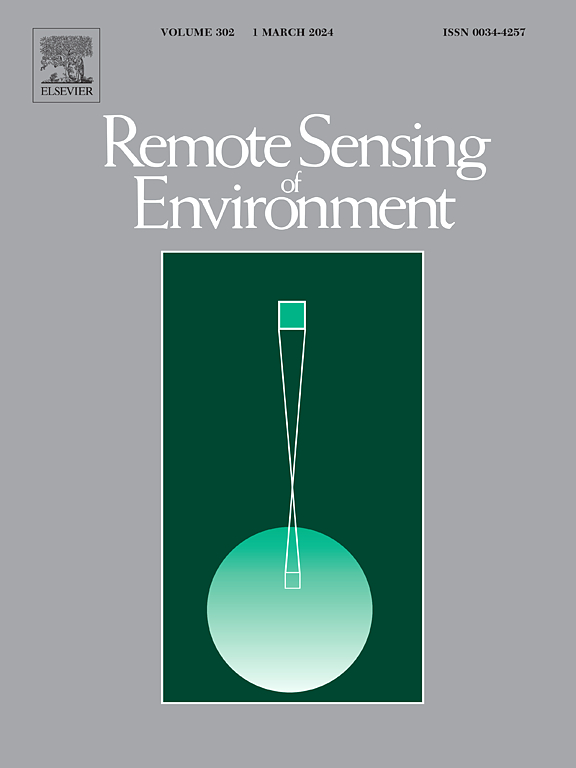The Harmonized Landsat and Sentinel-2 version 2.0 surface reflectance dataset
IF 11.1
1区 地球科学
Q1 ENVIRONMENTAL SCIENCES
引用次数: 0
Abstract
Frequent multispectral observations of sufficient spatial detail from well-calibrated spaceborne sensors are needed for large-scale terrestrial monitoring. To meet this demand, the NASA Harmonized Landsat and Sentinel-2 (HLS) project was initiated in early 2010s to produce comparable 30-m surface reflectance from the US Landsat 8 Operational Land Imager (OLI) and the European Copernicus Sentinel-2A MultiSpectral Instrument (MSI), and currently from two OLI and two MSI sensors, by applying atmospheric correction to top-of-atmosphere (TOA) reflectance, masking out clouds and cloud shadows, normalizing bi-directional reflectance view angle effects, adjusting for sensor bandpass differences with the OLI as the reference, and providing the harmonized data in a common grid. Several versions of HLS dataset have been produced in the last few years. The recent improvements on almost all the harmonization algorithms had prompted a production of a new HLS dataset, tagged Version 2.0, which was completed in the summer of 2023 and for the first time takes on a global coverage (except for Antarctica). The HLS V2.0 data record starts in April 2013, two months after Landsat 8 launch. For 2022, the first whole year two Landsat and two Sentinel-2 satellites were available, HLS provides a global median of 66 cloud-free observations over land, substantially more than from a single sensor. This paper describes the HLS algorithm improvements and assesses the harmonization efficacy by examining how the reflectance difference between contemporaneous Landsat and Sentinel-2 observations was successively reduced by each harmonization step. The assessment was conducted on 545 pairs of globally distributed same-day Landsat/Sentinel-2 images from 2021 to 2022. Compared to the TOA data, the HLS atmospheric correction slightly increased the reflectance relative difference between Landsat and Sentinel-2 for most of the spectral bands, especially for the two blue bands and the green bands. The subsequent bi-directional reflectance view angle effect normalization effectively reduced the between-sensor reflectance difference present in the atmospherically corrected data for all the spectral bands, and notably to a level below the TOA differences for the red, near-infrared (NIR), and the two shortwave infrared (SWIR) bands. The bandpass adjustment only had a modest effect on reducing the between-sensor reflectance difference. In the final HLS products, the same-day reflectance difference between Landsat and Sentinel-2 was below 4.2% for the red, NIR, and the two SWIR bands, all smaller than the difference in the TOA data. However, the between-sensor differences for the two blue and the green bands remain slightly higher than in TOA data, and this reflects the difficulty in accurately correcting for atmospheric effects in the shorter wavelength visible bands. The data consistency evaluation on a suite of commonly used vegetation indices (VI) calculated from the HLS V2.0 reflectance data showed that the between-sensor VI difference is below 4.5% for most of the indices. These results suggest that the harmonization is robust and the HLS V2.0 data are adequate for quantitative terrestrial applications.
统一的Landsat和Sentinel-2 2.0版地表反射率数据集
大规模地面监测需要来自校准良好的星载传感器的频繁多光谱观测,以获得足够的空间细节。为了满足这一需求,NASA协调Landsat和Sentinel-2 (HLS)项目于2010年代初启动,通过美国Landsat 8操作陆地成像仪(OLI)和欧洲哥白尼哨兵- 2a多光谱仪器(MSI),以及目前使用的两个OLI和两个MSI传感器,通过对大气顶(TOA)反射率进行大气校正,屏蔽云和云阴影,标准化双向反射视角效应,产生可比较的30米表面反射率。以OLI为基准调整传感器带通差,并在公共网格中提供协调数据。在过去的几年中,已经产生了几个版本的HLS数据集。最近对几乎所有协调算法的改进促使新的HLS数据集的产生,标记为2.0版本,该数据集于2023年夏季完成,首次具有全球覆盖范围(南极洲除外)。HLS V2.0数据记录始于2013年4月,也就是陆地卫星8号发射两个月后。2022年,两颗Landsat卫星和两颗Sentinel-2卫星全部可用,HLS提供了66个全球无云陆地观测的中位数,远远超过单个传感器。本文描述了HLS算法的改进,并通过考察同步Landsat和Sentinel-2观测值之间的反射率差如何在每个协调步骤中依次减小来评估协调效果。该评估是对2021年至2022年全球分布的545对当日Landsat/Sentinel-2图像进行的。与TOA数据相比,HLS大气校正略微增加了Landsat与Sentinel-2在大部分光谱波段的反射率相对差值,尤其是蓝波段和绿波段的反射率相对差值。随后的双向反射率视角效应归一化有效地降低了大气校正数据中所有光谱波段的传感器间反射率差异,并显著降低了红色、近红外(NIR)和两个短波红外(SWIR)波段的TOA差异。带通调整仅对减小传感器间反射率差有适度的影响。在最终的HLS产品中,Landsat和Sentinel-2在红色、近红外和两个SWIR波段的当日反射率差异小于4.2%,均小于TOA数据的差异。然而,蓝色和绿色波段的传感器间差异仍然略高于TOA数据,这反映了在较短波长的可见波段准确校正大气效应的难度。对HLS V2.0反射率数据计算的一套常用植被指数(VI)数据一致性评价表明,大多数指数的传感器间VI差异在4.5%以下。这些结果表明,调和是稳健的,HLS V2.0数据足以用于定量的地面应用。
本文章由计算机程序翻译,如有差异,请以英文原文为准。
求助全文
约1分钟内获得全文
求助全文
来源期刊

Remote Sensing of Environment
环境科学-成像科学与照相技术
CiteScore
25.10
自引率
8.90%
发文量
455
审稿时长
53 days
期刊介绍:
Remote Sensing of Environment (RSE) serves the Earth observation community by disseminating results on the theory, science, applications, and technology that contribute to advancing the field of remote sensing. With a thoroughly interdisciplinary approach, RSE encompasses terrestrial, oceanic, and atmospheric sensing.
The journal emphasizes biophysical and quantitative approaches to remote sensing at local to global scales, covering a diverse range of applications and techniques.
RSE serves as a vital platform for the exchange of knowledge and advancements in the dynamic field of remote sensing.
 求助内容:
求助内容: 应助结果提醒方式:
应助结果提醒方式:


